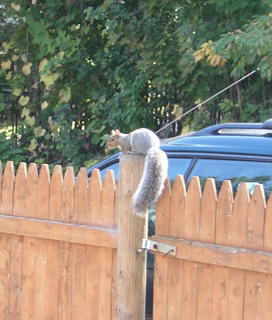Prey
 This grey squirrel (Sciurus carolinensis) lives in a nest in the Norway spruce (Picea abies) tree at the corner of the yard. She or he summered in the trees next to the Mill Pond, but has moved back to the vicinity of my yard since August when the sunflowers and watermelon started coming in. This one got both of the backyard sunflowers and about an eighth of one of the front yard sunflowers. It ate an entire watermelon and took bites out of the zuchinni and gourd (it didn't like either squash). It has also buried and stored hundreds of nuts around the neighborhood. I see it wander across the right of way find a spot on the ground, dig a few inches down and pull out a well seasoned nut. It will be busy restoring in the next following weeks. There is an enormous white oak just to the south of us and a scarlet oak growing up over the right-of-way outside my kitchen door. This squirrel has no doubt planted more of both across this little landscape. It eats only fruits and nuts, only has conflicts with woodpeckers, whose hollowed homes it likes to steal, yet it must fear for its life at the screetch of the red tailed hawk. As if to punctuate this point, three hawks glided overhead as I wrote those lines, battling with each other aggressively for air space, they circled and circled, slowly downstream, and the squirrel was suddenly absent. I have mixed emotions for this gray squirrel. I have cursed him or her for shredding a neighbor's red nylon scarf and throwing pieces in the Norway spruce. I have wished her or him harm after finding broken sunflower plants and scattered seed shells. I finally just had to laugh when I found the hollowed out watermelon in the front yard raised beds. This squirrel is at home in my yard, my home is in its yard, what else would I expect? This species is the most common of all wildlife species in eastern North America, it is the only wild critter that just about everyone has seen. It has adjusted to our presence, populated our parks, and inhabited our borderlands.
This grey squirrel (Sciurus carolinensis) lives in a nest in the Norway spruce (Picea abies) tree at the corner of the yard. She or he summered in the trees next to the Mill Pond, but has moved back to the vicinity of my yard since August when the sunflowers and watermelon started coming in. This one got both of the backyard sunflowers and about an eighth of one of the front yard sunflowers. It ate an entire watermelon and took bites out of the zuchinni and gourd (it didn't like either squash). It has also buried and stored hundreds of nuts around the neighborhood. I see it wander across the right of way find a spot on the ground, dig a few inches down and pull out a well seasoned nut. It will be busy restoring in the next following weeks. There is an enormous white oak just to the south of us and a scarlet oak growing up over the right-of-way outside my kitchen door. This squirrel has no doubt planted more of both across this little landscape. It eats only fruits and nuts, only has conflicts with woodpeckers, whose hollowed homes it likes to steal, yet it must fear for its life at the screetch of the red tailed hawk. As if to punctuate this point, three hawks glided overhead as I wrote those lines, battling with each other aggressively for air space, they circled and circled, slowly downstream, and the squirrel was suddenly absent. I have mixed emotions for this gray squirrel. I have cursed him or her for shredding a neighbor's red nylon scarf and throwing pieces in the Norway spruce. I have wished her or him harm after finding broken sunflower plants and scattered seed shells. I finally just had to laugh when I found the hollowed out watermelon in the front yard raised beds. This squirrel is at home in my yard, my home is in its yard, what else would I expect? This species is the most common of all wildlife species in eastern North America, it is the only wild critter that just about everyone has seen. It has adjusted to our presence, populated our parks, and inhabited our borderlands.Its large numbers and wide habitat range makes it the common prey of hawk and coyote and feral dog, even kingfisher will try for one. It is a well-fed and comfortable species. Is my ambivalence toward it something akin to my ambivalence toward many of the other signatures of modernism? I do not deny the creature its right to live, and I feel a tinge of sorrow at the kill-site whenever the hawks get the best of it, I even grudgingly respect its work ethic, memory, and good planning. I like this particular individual, having watched it for the full cycle of seasons. But the bigger picture drawn by the lack of diversity among our backyard wildlife that is embodied and represented by this image of this individual gray squirrel, whose species is known to all and whose shape is familiar to everyone, is disheartening. There are many birds, there are many plants, but there are not too very many wild mammals bigger than this one in our immediate and every day experience, most of us. It must lead to an undernourished imagination, eventually, losing this vital segment of experienced life. Possibly it could lead one to assert fantastical explanations and justifications where white ash (Fraxinus americana) has been growing strong for centuries, to contend debate against one's own mirror image.

0 Comments:
Post a Comment
<< Home